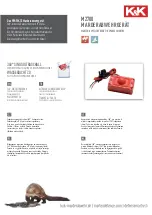
CFM100 CompactFlash
®
Module
7
e)
Formatting memory drives
f)
Deleting data files
Test the power-up functions in the office before going into
the field to ensure the power-up file is configured correctly.
The key to the CF power-up function is the powerup.ini file, which contains a
list of one or more command lines. At power-up, the powerup.ini command
line is executed prior to compiling the program. Powerup.ini performs three
operations:
1)
Copies the specified program file to a specified memory drive
2)
Sets a file attribute on the program file
3)
Optionally deletes CF data files from the overwritten (just previous)
program
Powerup.ini takes precedence during power-up. Though it sets file attributes
for the programs it uploads, its presence on the CF does not allow those file
attributes to control the power-up process. To avoid confusion, either remove
the CF card or delete the powerup.ini file after the powerup.ini upload.
7.1.3.1 Creating and Editing Powerup.ini
Powerup.ini is created with a text editor, and saved as “powerup.ini”.
Some text editors (such as WordPad) will attach header
information to the powerup.ini file causing it to abort. Check the
text of a powerup.ini file with the datalogger keyboard display to
see what the datalogger actually sees.
Comments can be added to the file by preceding them with a single-quote
character (‘). All text after the comment mark on the same line is ignored.
Syntax
Syntax allows functionality comparable to File Control in LoggerNet.
Powerup.ini is a text file that contains a list of commands and parameters. The
syntax for the file is:
Command,File,Device
where
Command = one of the numeric commands in TABLE
File = file on CF associated with the action. Name can be up to 22
characters.
Device = the device to which the associated file will be copied. Options
are CPU:, USR:, and CRD:. If left blank or with an invalid option, it will
default to CPU:.
CAUTION
NOTE














































